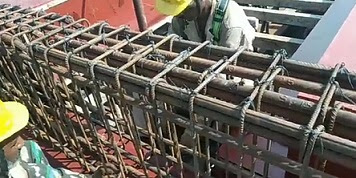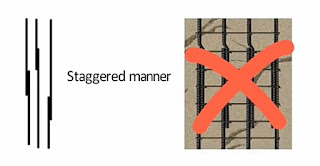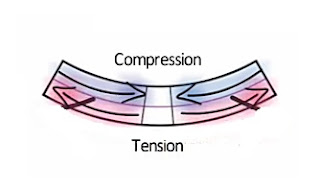Table of Contents
What is Lap Length?
The lap length is the length provided to overlap two rebars in order to safely transfer load from one bar to another bar and an alternative to this is to provide mechanical couplers. It is also known as lap splices.
Why it is provided?
Suppose we need to construct the building of 30-meter height but there is no 30-meter single bar available in the market. The maximum length of Steel bar available in the market is usually 12 meters.
Why12meter?
It is because of the transportation problem and manufacturing difficulty so we need to join three bars of 12 metres to get 30 metres bar.
What will happen if we don’t provide lap length?
If we don’t provide lap length then the load transfer mechanism will fail which eventually leads to failure of structure also if we provide less lap length than the required then the reinforcement bar split and Crack can be developed in the concrete.

How to calculate lap length?
The calculations for tension zone and compression zone are different. Let us take the case of the beam.
When the beam is subjected to forces in a building the bottom portion of the beam experiences tension and the top portion of the beam experiences compression so, first we will discuss about tension zone.
In, tension zone, there are two cases
- one flexural tension
- direct tension
According to IS 456: 2000
For flexural tension, the lap length shall be Ld that is development length, or 30d whichever is greater is considered. Where d is the diameter of the bar. Generally, the development length is 41d where d is the diameter of the bar.
For direct tension, the lap length should be 2 Ld or 30d whichever is greater is considered. In this case, the straight length of the lapping bar shall not be less than 15d or 20cm.
In compression
In the case of compression, the lap length is equal to the development length calculated in compression but not less than 24d.
What are the general rules for lap length?
For the different diameters of bars
When the bars of different diameters are to be spliced the lap length is calculated considering the smaller diameter bars.
Suppose you are constructing a column, from bottom 20 mm diameter bar is coming and from here 16 mm diameter bar has to be spliced then for calculating lap length 16 mm diameter should be considered and not 20 mm.
If the diameter of the bar is more than 36 mm then lapping should not be done instead of lapping, this bar should be welded.
But when welding is not possible then lapping can be permitted for bars larger than 36 mm but in this case, additional spirals shall be provided around the lapped bar.

Lapping should be done in a staggered manner. These laps should not be given at the same level to avoid buckling. The stirrup shall be closely spaced in the lapping portion.
It’s because when we provide lapping in concrete members the strength of the member slightly reduces. Hence, we need to provide more numbers of stirrups in this portion.

In the case of bundled bars, lap splices of bundle bars shall be made by splicing one bar at a time. Such individual splices within a bundle shall be staggered.
In this image you can see some amount of rebar is left for future construction with extra rebar will be needed for tying bars of the column. This extra length of rebar is also called lap length.
Also, Read – What is Concrete Cover? – Clear Cover, Nominal Cover and Effective Cover
Lapping zone
Lapping Zone For Column

This is the column. L is the length of the column. In the case of the column, the tension zone is located at an L/4 distance from both ends of the column. This zone experiences tension so here we should not provide lapping.
The bending moment at the middle portion of the column is zero it means the middle portion of the column is least stressed. Hence, lapping should be provided in the mid-section of the column so that transfer of stresses from bar to bar happens smoothly in this region.
Lapping Zone For Beam

Whereas in the case of the beam as I already explained before the top portion of the beam experiences compression and the bottom portion experiences tension.
So, the top reinforcement in the beam is left at the midspan. As the beam does not experience any negative moment at midspan so lapping is great in this region.
In the case of bottom reinforcement, the lapping is provided near the ends of the beam or L/4 distance from column face but should not be in the midpoint of the beam, and one last point The lapping should not be provided at joints.
Lapping Zone for Slab

The function of the RCC slab is similar to the beam if it is designed in one way slab. The perfect position for lapping is at where the bending moment is least, the point of contra flexure.
For bottom reinforcement, laps are provided L/5 to L/3 distance from the support. ( L = effective span)
For top reinforcement, no lap is required since they are generally short. Although In no case, the lapped bars should not exceed one-third of the total bars.
In the two-way slab, the same practice as mentioned above should be followed for both directions.
If an end-to-end distance between the lap is the least, then the lap should be provided in a staggered manner. ( lap length +75 mm)
Generally, the lap length provided for the slab is 60d, column 45d, and the beam is 60d for the M20 grade of concrete.
FAQs
What is the lap length?
It is the length provided to overlap two rebars in order to safely transfer load from one bar to another bar and the alternative to this is, to provide mechanical couplers.
What is the minimum lap length?
For direct tension, the straight length of the lapping bar shall not be less than 15d or 20 cm. While in the case of compression lapping should not be less than 24d.
What is the difference between lap length and development length?
Lap length is provided to safely transfer stresses from one bar to another, while development is needed to safely transfer the stresses from steel bar to concrete to make a continuous structure.
Where lap length is provided in the column?
The bending moment at the middle portion of the column is zero it means the middle portion of the column is least stressed. Hence, lapping should be provided in the mid-section of the column.
Final Words
I hope now you understood the concept of Lap Length. If you find this article helpful please don’t forget to share it.
If you want to add any information which I have missed in this article you can mention it in the comment section.
Finally thanks! for reading the article.
Also, read
Difference Between One way and Two way Slab
Difference Between Lap length and Development Length
Grade of Cement – Difference Between 33, 43 and 53 Grade Cement
Plum Concrete – Purpose, Ratio, Specification and Uses
Concrete Mix Ratio – Types, Proportioning of Concrete Mix and & Methods
How to Calculate Cement, Sand and Aggregate Quantity in Concrete?
Really good article.
It would have been better to involve sone sketches
And calculation.
Thanks for commenting, I’m glad that you find my article helpful.
The article is very helpful, it clears the doubts related to lapping length Would suggest if u can add photos with same will be more beneficial.
Thanks for your valuable feedback. I am grateful you find my article helpful I will update it soon.
Useful article. In article, lap length for flexural tension and direct tension were detailed. My doubt is what is the difference between flexural tension and direct tension of steel bars and how to differentiate it for use in construction?
Hi Ravichandran,
Thanks for your valuable feedback. I am glad my content helps you.
Flexural tension means tension due to bending. For instance, when a load is applied on a beam it’s top part experience compression and bottom part experience tension. The tension on the bottom part due to bending of the beam is flexural tension.
For easy understanding, let’s correlate tension-compression with the change in length.
Tension means an increase in length and compression means a decrease in length.
When there is an increase in the length of the member occur without any twisting or bending of the member (that means the member remain straight after the application of load) then it can be said that member is subjected to direct tension.
For example, when a load is applied on a hook then it is subjected to direct tension.
I hope it helps you.
Thanks!